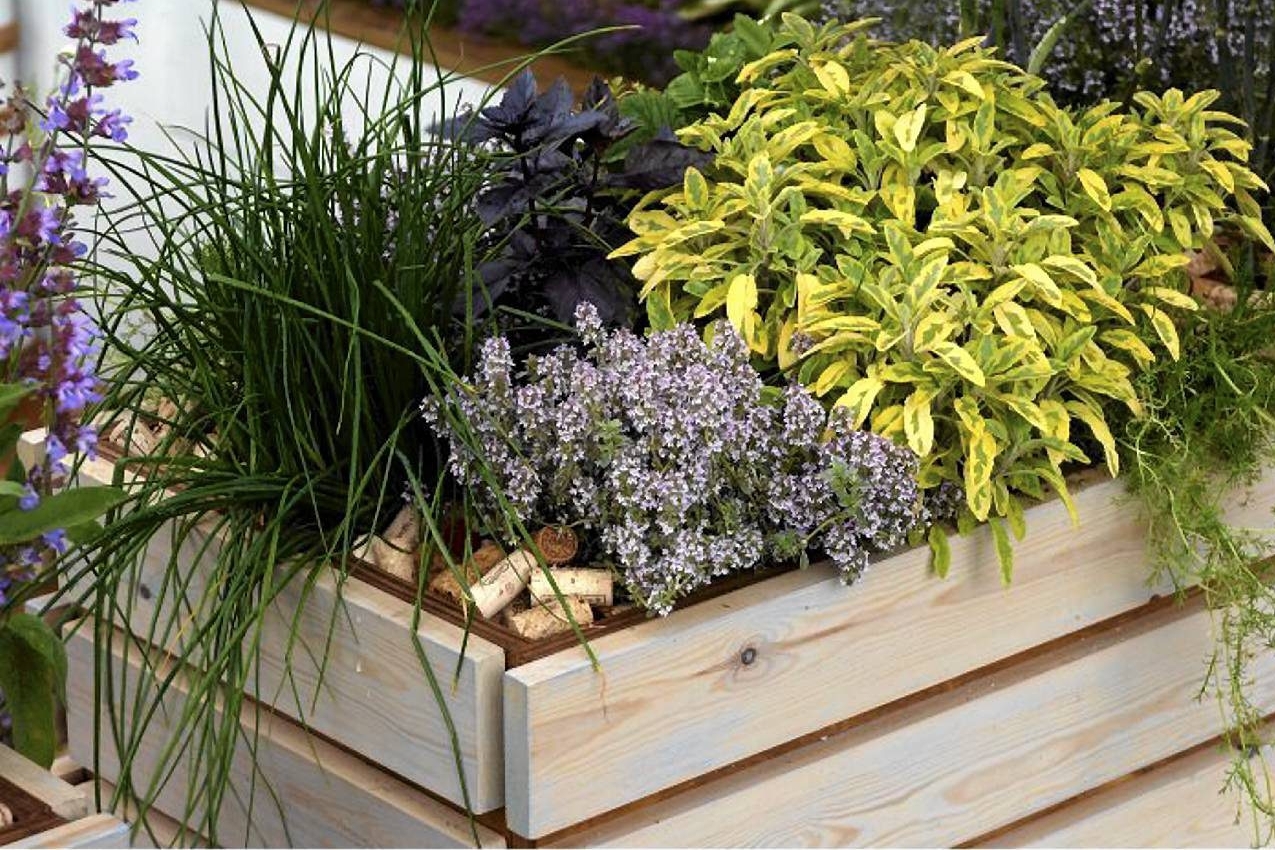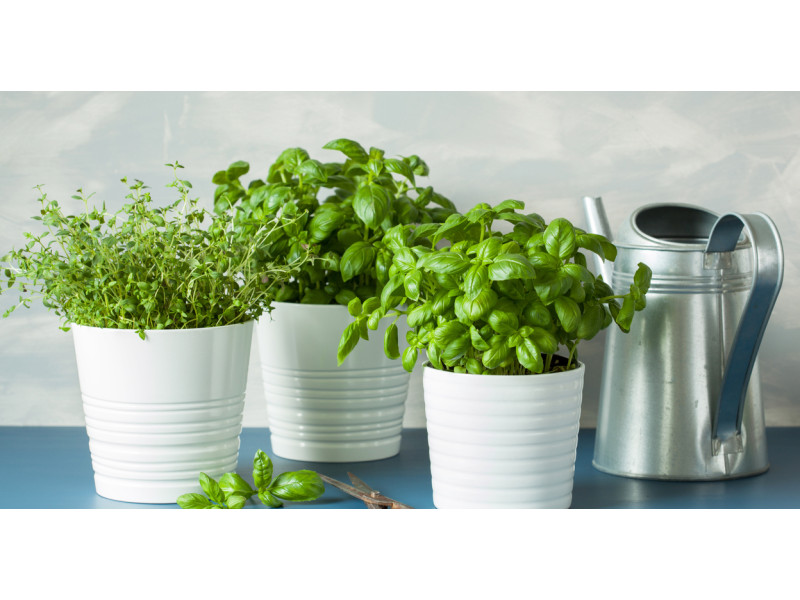This spring we envy the happy owners of six hundred acres: in addition to the usual berries and vegetables, they have access to fresh air. Well, if there is only an apartment for a walk, then a dacha with a vegetable garden should be arranged on the balcony. With many plants this season, it is not too late to start ;)
If the balcony is located in close proximity to a busy street filled with dust and exhaust fumes, it is not worth growing vegetables or herbs on it, as they absorb all the harmful substances. But inside the apartment complex, we can plant edible plants on the balcony.
Choosing pots
Pots for growing herbs and vegetables on the balcony should be massive and heavy - so that even with a strong gust of wind they do not fall. It is better to choose large wooden boxes, because you can plant many plants in them, which makes further care much easier.

Greens can also be grown in small pots, but then preferably in clay pots, because the soil in them does not dry out as quickly as in plastic pots.
Hanging flower pots and flower boxes mounted on the railing are also very popular on balconies. This is a practical solution, especially for a small balcony.
You should not choose containers with a diameter of less than 10 cm - in such containers the soil dries out very quickly on hot summer days. The boxes must have drainage holes, otherwise the roots will rot from excess moisture. The bottom should be laid with a layer (approximately 2 cm) of small pebbles, crushed stone or expanded clay - the so-called drainage, which allows water to drain freely, preventing root rot.
Pots with any plants should be rotated from time to time so that the plants have equal access to light from all sides.

What kind of soil?
Regular garden soil is best; when buying it at the store, choose the so-called all-purpose. It is advisable to immediately mix the soil with a slow-release granular fertilizer, which will gradually release nutrients that are absorbed by the roots.
After planting, it is necessary to ensure that the soil in the pots is constantly moist; drying out can be fatal for plants that have not yet taken root well. But watering should be moderate, without overflowing, only in the early morning or evening. And never during strong sunlight.
Green
In boxes and pots on a balcony or terrace, you can grow both annual herbs (basil or marjoram) and perennial species - thyme, sage, mint, marjoram, etc.
Remember that perennial species require protection from frost and flooding during thaws.
Seeds are cheaper than seedlings, but growing plants from them requires some care and patience. When choosing herb seedlings, we immediately have large plants, but this is a rather expensive solution. In addition, in stores, as a rule, there is a small selection.
The easiest thing that even children can plant is green onions. You can pick sprouted bulbs, germinate them yourself, or buy seeds. Onions are absolutely unpretentious, and you can harvest them gradually, as needed, by plucking off the outer feathers.

When growing dill, choose low varieties, prune the greens so that the bush grows wide and the first harvest appears in a month.
Arugula germinates well and the first sprouts appear on the balcony in a week. Bushes 10 cm high must be pruned, otherwise the arugula stops growing and loses its spicy taste. And instead of watering, it really likes spraying from a spray bottle.
Basil: in addition to seeds or ready-made seedlings, it is very easy to grow it from a sprig. To do this, dip a few small sprigs of basil in water for 3-6 days. They will quickly take root, and you will significantly speed up the growing process. Remember that basil loves the sun and heat, so the north side is not a helper.
Oregano doesn't require any care at all, other than regular watering. And if you want to dry it for winter pizza, do it before it blooms.
Melissa grows slowly in its first year of life. But it can safely overwinter on a windowsill. In the first summer, cut off the shoots, leaving the stems at a distance of 10 cm from the ground, and the lemon balm bushes will soon delight you with their splendor. Flower buds should be pinched off.

Celery and parsley are easy to grow from the root. To do this, you need to cut the root into small pieces so that each has a stalk. Both of these plants are grown on the balcony more for greenery, because the underground parts will mostly not be impressive.
Vegetables and berries
Vegetables require a lot of minerals, so they require a large container. And they will need more sun to ripen than many types of greens.

You can even grow potatoes on your balcony. There are special two-layer pots on sale, for harvesting as they ripen, without digging up the whole tuber. But, firstly, potatoes are quite banal, and secondly, growing them takes up a lot of space. Therefore, we will focus on small plants.
Small varieties of tomatoes, such as "Talisman" or "Coral", do well in a more or less small box or bucket.

Next to the bush, stick a peg into the ground to which the shoots of the plant will be attached. One bush can produce more than 30 such tomatoes.
Pepper: you can also go for large, fleshy peppers, but mini peppers are more affordable, spectacular, and exotic.

A bush of hot pepper varieties, generously covered with bright fruits, will please the eye for a long time: after all, such a harvest is eaten slowly. And sweet varieties are more capricious, but this trouble is worth it.

However, keep in mind that you cannot plant different varieties next to each other, otherwise cross-pollination will occur and sweet paprika can turn into devil's chili.
Strawberries are quite delicate berries, but you shouldn't deny yourself out of fear. Having dealt with the soil, fertilizers, and pollination, don't forget to remove all the tendrils in time, because they take energy and nutrients from the plant, and the berries simply don't ripen.
Carrots – young, sweet and juicy – are a healthy crunchy treat. There are a dozen or so varieties that thrive in closed ground. On the balcony, you will need boxes at least 15 cm high, and the first seedlings will need to be thinned out and covered with foil.
It is too late to plant many crops, but it is worth trying next year. For example, cucumbers, radishes, peas, eggplants, zucchini, cabbage take root perfectly on the balcony. A balcony fence is perfect for supporting climbing plants.
Flower and vegetable arrangements on the balcony

Compositions that combine useful and ornamental plants are currently at the peak of fashion. It is only important to compare them in terms of requirements and give them a sufficiently large container.
A meter-long tomato with clusters of small fruits goes well with orange marigolds and beets with decorative purple leaves. Nasturtiums can grow next to beans, and purple basil with yellow peppers. Don't be afraid of different original combinations.

The harvest from the balcony garden will not be large, but it is very nice to realize that, without leaving the house, we have fresh green onions for scrambled eggs, basil for tomatoes (of course, also our own), or lemon balm for brewing tea before bed.
Flower garden

In addition to its aesthetic function, a flower garden on a balcony garden will also attract insects, which are so necessary for pollinating all plants.

For example, fragrant tobacco is very popular with bees, nasturtium will bloom all summer, petunia is absolutely unpretentious, and blooms for a couple of months and looks very bright. Geranium is suitable for both the hot south side and the shady north side.

Pansies also bloom almost all summer and require no care other than watering, spectacular bougainvillea looks amazing in hanging rosettes. And heather will bloom even in winter on an open balcony.


Write a comment